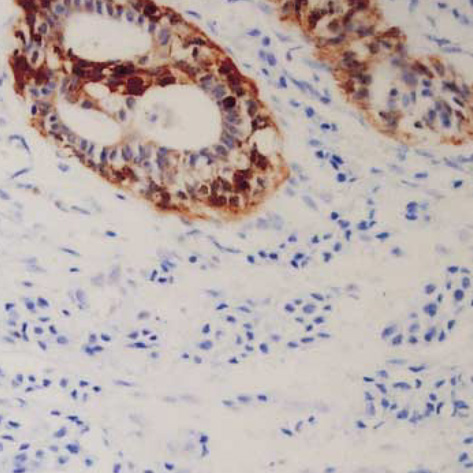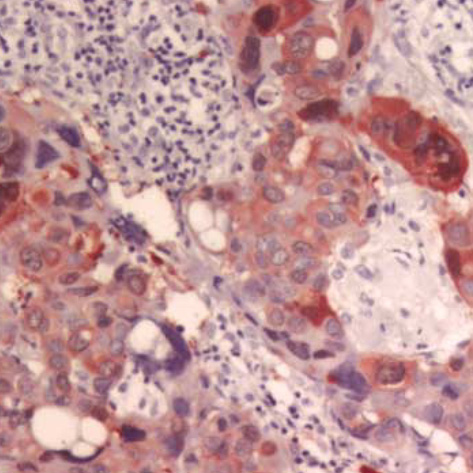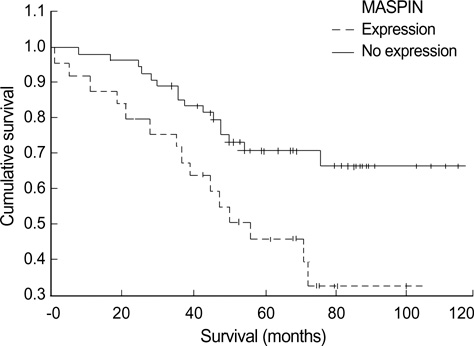J Korean Med Sci.
2006 Apr;21(2):309-314. 10.3346/jkms.2006.21.2.309.
Clinicopathological Significance of Maspin Expression in Breast Cancer
- Affiliations
-
- 1Department of Pathology, College of Medicine, Chosun University, Gwangju, Korea. mjblee@chosun.ac.kr
- 2Department of Pathology, College of Medicine, Yanbian University, Jilin, China.
- KMID: 1781841
- DOI: http://doi.org/10.3346/jkms.2006.21.2.309
Abstract
- Maspin is a unique serine proteinase inhibitor that has tumor suppressor activity. It has been reported that maspin is expressed in normal human mammary epithelial cells and it is down-regulated during the progression of cancer. However, to date, there is very limited data on the clinical significance of maspin expression in human breast cancer. In this study, maspin expression was assessed immunohistochemically from 80 invasive ductal carcinoma (IDC) specimens of the breast. Also, maspin expression was compared with the clinicopathological factors (age, grade, tumor size and lymph node status), the expression of estrogen receptor (ER), progesterone receptor (PR) and p53, DNA ploidy and the overall survival in an attempt to assess its prognostic value. The maspin expression was positive in 25 IDC cases (31.3%). The maspin expression in IDC was significantly correlated with a higher histologic grade, a larger tumor size, a positive p53 status and shorter survival. There was an inverse association with maspin expression and the PR status. These findings suggest that maspin expression is not down-regulated with the progression of cancer and maspin expression may be associated with a poor prognosis. The immunohistochemical detection of maspin in breast cancers may be helpful for predicting an aggressive phenotype.
Keyword
MeSH Terms
-
Tumor Suppressor Protein p53/metabolism
Survival Rate
Serpins/*metabolism
Receptors, Progesterone/metabolism
Receptors, Estrogen/metabolism
Prognosis
Ploidies
Middle Aged
Humans
Genes, Tumor Suppressor
Female
DNA, Neoplasm/analysis/genetics
Carcinoma, Ductal, Breast/genetics/*metabolism/mortality/pathology
Breast Neoplasms/genetics/*metabolism/mortality/pathology
Aged
Adult
Figure
Reference
-
1. Duffy MJ, McCarthy K. Matrix metalloproteinases in cancer: prognostic markers and targets for therapy (review). Int J Oncol. 1998. 12:1343–1348.
Article2. Zhang M, Magit D, Botteri F, Shi HY, He K, Li M, Furth P, Sager R. Maspin plays an important role in mammary gland development. Dev Biol. 1999. 215:278–287.
Article3. Zou Z, Anisowicz A, Hendrix MJ, Thor A, Neveu M, Sheng S, Rafidi K, Seftor E, Sager R. Maspin, a serpin with tumor-suppressing activity in human mammary epithelial cells. Science. 1994. 263:526–529.
Article4. Sheng S, Carey J, Seftor EA, Dias L, Hendrix MJ, Sager R. Maspin acts at the cell membrane to inhibit invasion and motility of mammary and prostatic cancer cells. Proc Natl Acad Sci USA. 1996. 93:11669–11674.
Article5. Zhang M, Volpert O, Shi YH, Bouck N. Maspin is an angiogenesis inhibitor. Nat Med. 2000. 6:196–199.
Article6. Zou Z, Gao C, Nagaich AK, Connell T, Saito S, Moul JW, Seth P, Appella E, Srivastava S. p53 regulates the expression of the tumor suppressor gene maspin. J Biol Chem. 2000. 275:6051–6054.
Article7. Umekita Y, Ohi Y, Sagara Y, Yoshida H. Expression of maspin predicts poor prognosis in breast-cancer patients. Int J Cancer. 2002. 100:452–455.
Article8. Umekita Y, Yoshida H. Expression of maspin is up-regulated during the progression of mammary ductal carcinoma. Histopathology. 2003. 42:541–545.
Article9. Mohsin SK, Zhang M, Clark GM, Craig Allred D. Maspin expression in invasive breast cancer: association with other prognostic factors. J Pathol. 2003. 199:432–435.
Article10. Ito Y, Yoshida H, Tomoda C, Uruno T, Takamura Y, Miya A, Kobayashi K, Matsuzuka F, Matsuura N, Kuma K, Miyauchi A. Maspin expression is directly associated with biological aggressiveness of thyroid carcinoma. Thyroid. 2004. 14:13–18.
Article11. Elston CW, Ellis IO. Pathological prognostic factors in breast cancer. I. The value of histological grade in breast cancer: experience from a large study with long-term follow-up. Histopathology. 1991. 19:403–410.
Article12. Duffy MJ, Reilly D, O'Sullivan C, O'Higgins N, Fennelly JJ, Andreasen P. Urokinase-plasminogen activator, a new and independent prognostic marker in breast cancer. Cancer Res. 1990. 50:6827–6829.13. Potempa J, Korzus E, Travis J. The serpin superfamily of proteinase inhibitors: structure, function, and regulation. J Biol Chem. 1994. 269:15957–15960.
Article14. Hojo T, Akiyama Y, Nagasaki K, Maruyama K, Kikuchi K, Ikeda T, Kitajima M, Yamaguchi K. Association of maspin expression with the malignancy grade and tumor vascularization in breast cancer tissues. Cancer Lett. 2001. 171:103–110.
Article15. Maass N, Hojo T, Rosel F, Ikeda T, Jonat W, Nagasaki K. Down regulation of the tumor suppressor gene maspin in breast carcinoma is associated with a higher risk of distant metastasis. Clin Biochem. 2001. 34:303–307.
Article16. Sternlicht MD, Kedeshian P, Shao ZM, Safarians S, Barsky SH. The human myoepithelial cell is a natural tumor suppressor. Clin Cancer Res. 1997. 3:1949–1958.17. Maass N, Teffner M, Rosel F, Pawaresch R, Jonat W, Nagasaki K, Rudolph P. Decline in the expression of the serine proteinase inhibitor maspin is associated with tumour progression in ductal carcinomas of the breast. J Pathol. 2001. 195:321–326.
Article18. Maass N, Hojo T, Ueding M, Luttges J, Kloppel G, Jonat W, Nagasaki K. Expression of the tumor suppressor gene Maspin in human pancreatic cancers. Clin Cancer Res. 2001. 7:812–817.19. Sood AK, Fletcher MS, Gruman LM, Coffin JE, Jabbari S, Khalkhali-Ellis Z, Arbour N, Seftor EA, Hendrix MJ. The paradoxical expression of maspin in ovarian carcinoma. Clin Cancer Res. 2002. 8:2924–2932.20. Xia W, Lau YK, Hu MC, Li L, Johnston DA, Sheng S, El-Naggar A, Hung MC. High tumoral maspin expression is associated with improved survival of patients with oral squamous cell carcinoma. Oncogene. 2000. 19:2398–2403.
Article21. Pemberton PA, Tipton AR, Pavloff N, Smith J, Erickson JR, Mouchabeck ZM, Kiefer MC. Maspin is an intracellular serpin that partitions into secretory vesicles and is present at the cell surface. J Histochem Cytochem. 1997. 45:1697–1706.
Article22. Chu YC, Park IS, Kim YJ, Kim JM, Han HS, Han JY, Kim YB. Expression of maspin protein in ductal hyperplasia, intraductal carcinoma and invasive ductal carcinoma of the breast. Korean J Pathol. 1999. 33:614–619.23. Zhang W, Zhang M. Tissue microarray analysis of maspin expression and its reverse correlation with mutant p53 in various tumors. Int J Oncol. 2002. 20:1145–1150.
Article
- Full Text Links
- Actions
-
Cited
- CITED
-
- Close
- Share
- Similar articles
-
- Prognostic Significance of Maspin in Pancreatic Ductal Adenocarcinoma
- Expression of Maspin is associated with the Intestinal Type of Gastric Adenocarcinoma
- The Role of Neutrophil Estrogen Receptor Status on Maspin Synthesis via Nitric Oxide Production in Human Breast Cancer
- Expression of Maspin Protein in Ductal Hyperplasia, Intraductal Carcinoma and Invasive Ductal Carcinoma of the Breast
- Expression of Maspin in Squamous Cell Carcinoma of the Head and Neck





